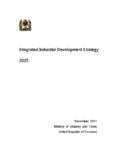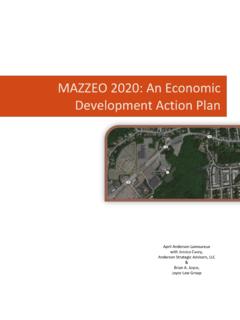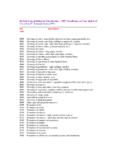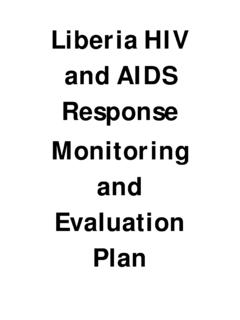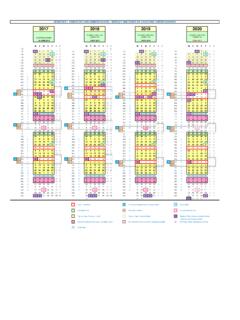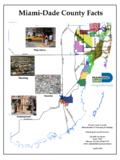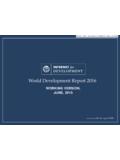Transcription of 2012 POPULATION AND HOUSING CENSUS - tzdpg.or.tz
1 The United Republic of Tanzania 2012 POPULATION AND HOUSING CENSUS POPULATION Distribution by Administrative Areas and March, 2013 Office of Chief Government Statistician President s Office, Finance, Economy and Development Planning Zanzibar National Bureau of Statistics Ministry of Finance Dar es Salaam i Foreword The 2012 POPULATION and HOUSING CENSUS (PHC) for United Republic of Tanzania was carried out on the 26th August, 2012 . This was the fifth CENSUS after the Union of Tanganyika and Zanzibar in 1964. Other Censuses were carried out in 1967, 1978, 1988 and 2002. The 2012 PHC, like others, will contribute to the improvement of quality of life of Tanzanians through the provision of current and reliable data for development planning, policy formulation and services delivery as well as for monitoring and evaluating national and international development frameworks.
2 The 2012 PHC is unique in the sense that, the information collected will be used in monitoring and evaluating the Development Vision 2025 for Tanzania Mainland and Zanzibar Development Vision 2020, Five Year Development Plan 2011/12 2015/16, National Strategy for Growth and Reduction of Poverty (NSGRP) commonly known as MKUKUTA and Zanzibar Strategy for Growth and Reduction of Poverty (ZSGRP) commonly known as MKUZA. The CENSUS will also provide information for the evaluation of the Millennium Development Goals (MDGs) in 2015. The Poverty Monitoring Master Plan, which is the monitoring tool for NSGRP and ZSGRP, mapped out core indicators for poverty monitoring against the sequence of surveys, with the 2012 CENSUS being one of them. Several of these core indicators for poverty monitoring will be measured directly from the 2012 CENSUS .
3 The CENSUS will also provide a denominator for the determination of other indicators such as enrolment and literacy rates, infant and maternal mortality rates, unemployment rate and others. The General Report on POPULATION Distribution by Administrative Units is the first of a series of publications planned for the 2012 PHC. The main purpose of the report is to give aggregated totals of POPULATION by sex. The report will also provide number of households, average household size, POPULATION densities, average annual inter-censal growth rates and sex ratios. Levels of aggregation are national, regional, district council and ward/shehia. The success of the CENSUS depended upon the cooperation and contributions from the government, development partners, various institutions and the public at large.
4 A special word of thanks should go to the government leaders at all levels particularly, Minister for Finance; Minister of State, President s Office, Finance, Economy and Development Planning, Zanzibar; Members of Parliament; Members of House of Representatives; Councilors; Regional and District CENSUS Committees chaired by Regional and District Commissioners; Field Assistants; Enumerators; Supervisors; local leaders and heads of households. Our special gratitude should go to the following; DfID, Government of Japan, JICA, UNDP, UNFPA, UNICEF, USAID, World Bank and other development partners for providing assistance in terms of equipment, long and short term consultancies, training and funding. We would like to thank ii religious and political party leaders, as well as Non-Governmental Organisations (NGOs), mass media and the general public for their contribution towards successful implementation of the CENSUS .
5 Last but not least, we would wish to acknowledge the vital contributions to the project by Hajjat Amina Mrisho Said, the 2012 Commissioner for POPULATION and HOUSING CENSUS and Mr. Mwalim Haji Ameir, the CENSUS Commissar for Zanzibar. Special thanks should also go to the Management and staff of the National Bureau of Statistics and Office of Chief Government Statistician, Zanzibar. Their commitment and dedication made significant contributions to the overall efficiency of the CENSUS operations. We would also like to convey our appreciation to all other Government Officials who worked tirelessly to ensure successful implementation of the 2012 POPULATION and HOUSING CENSUS . March, 2013 Hon. Mizengo Peter Pinda (MP), Prime Minister, United Republic of Tanzania Hon.
6 Ambassador Seif Ali Iddi (MP/MHR), Second Vice President, Zanzibar iii CENSUS Results in Brief Total POPULATION , Tanzania 44,928,923 Male POPULATION 21,869,990 Female POPULATION 23,058,933 Total POPULATION , Mainland 43,625,354 Male POPULATION 21,239,313 Female POPULATION 22,386,041 Total POPULATION , Zanzibar 1,303,569 Male POPULATION 630,677 Female POPULATION 672,892 Average Annual Intercensal Growth Rate, Tanzania, 2002 - 2012 Average Annual Intercensal Growth Rate, Mainland Average Annual Intercensal Growth Rate, Zanzibar Number of Households1, Tanzania 9,362,758 Number of Households, Mainland 9,109,150 Number of Households, Zanzibar 253,608 Average Household Size, Tanzania Average Household Size, Mainland Average Household Size, Zanzibar POPULATION Density, Tanzania 51 POPULATION Density, Mainland 49 POPULATION Density, Zanzibar 530 Sex Ratio.
7 Tanzania 95 Sex Ratio, Mainland 95 Sex Ratio, Zanzibar 94 1 Collective households included iv CONTENTS Page Foreword .. i CENSUS Results in Brief .. iii Concepts and Definitions .. xix Section A: Summary of Findings .. 1 Number of Persons .. 1 POPULATION by Region .. 1 Average Annual Growth Rates .. 3 POPULATION Density .. 6 Household Size .. 8 Sex Ratio .. 10 Regional POPULATION Distribution .. 11 List of Text Tables Table 1: POPULATION by Region and Average Annual Growth Rate, 2002 and 2012 Censuses .. 2 Table 2: Average Household Size by Region, 2002 and 2012 Censuses .. 9 Table 3: Regional POPULATION by Sex, Average Household Size and Sex Ratio .. 14 List of Figures Figure 1: POPULATION Trends in Tanzania, 1967 2012 Censuses .. 1 Figure 2: Average Annual Intercensal POPULATION Growth Rates, 1967 2012 Censuses.
8 3 Figure 3: Average Annual Intercensal POPULATION Growth Rate by Region, 2002 2012 Censuses .. 4 Figure 4: POPULATION Density by Region, 2012 CENSUS .. 6 Figure 5: Average Household Size by Region, 2012 CENSUS .. 8 Figure 6: Sex Ratio by Region, 2012 CENSUS .. 10 Figure 7: Trends in Sex Ratio, 1988 2012 Censuses .. 11 v List of Maps Map 1: Average Annual POPULATION Growth Rate by Region, 2002 2012 Censuses .. 5 Map 2: POPULATION Density by Region, 2012 CENSUS .. 7 Map 3: Percentage POPULATION Distribution by Region, Tanzania Mainland, 2012 CENSUS .. 12 Map 4: Percentage POPULATION Distribution by Region, Tanzania Zanzibar, 2012 CENSUS 13 Section B: POPULATION in the Regions, District Councils, Wards/Shehia by Sex, Average Household Size and Sex Ratio .. 15 Table 1. 0: POPULATION of Dodoma Region by Sex, Average Household Size and Sex Ratio.
9 17 Table 1. 1: POPULATION of Kondoa District Council by Sex, Average Household Size and Sex Ratio .. 18 Table 1. 2: POPULATION of Mpwapwa District Council by Sex, Average Household Size and Sex Ratio .. 19 Table 1. 3: POPULATION of Kongwa District Council by Sex, Average Household Size and Sex Ratio .. 20 Table 1. 4: POPULATION of Chamwino District Council by Sex, Average Household Size and Sex Ratio .. 21 Table 1. 5: POPULATION of Dodoma Municipal Council by Sex, Average Household Size and Sex Ratio .. 22 Table 1. 6: POPULATION of Bahi District Council by Sex, Average Household Size and Sex Ratio .. 23 Table 1. 7: POPULATION of Chemba District Council by Sex, Average Household Size and Sex Ratio .. 24 Table 2. 0: POPULATION of Arusha Region by Sex, Average Household Size and Sex Ratio.
10 26 Table 2. 1: POPULATION of Monduli District Council by Sex, Average Household Size and Sex Ratio .. 27 vi Table 2. 2: POPULATION of Meru District Council by Sex, Average Household Size and Sex Ratio .. 28 Table 2. 3: POPULATION of Arusha City Council by Sex, Average Household Size and Sex Ratio .. 29 Table 2. 4: POPULATION of Karatu District Council by Sex, Average Household Size and Sex Ratio .. 30 Table 2. 5: POPULATION of Ngorongoro District Council by Sex, Average Household Size and Sex Ratio .. 31 Table 2. 6: POPULATION of Arusha District Council by Sex, Average Household Size and Sex Ratio .. 32 Table 2. 7: POPULATION of Longido District Council by Sex, Average Household Size and Sex Ratio .. 33 Table 3. 0: POPULATION of Kilimanjaro Region by Sex, Average Household Size and Sex .. 35 Table 3.
